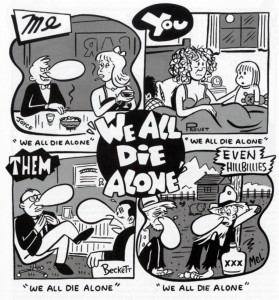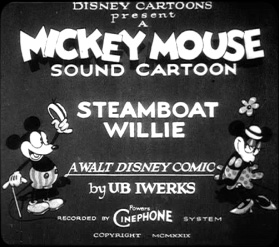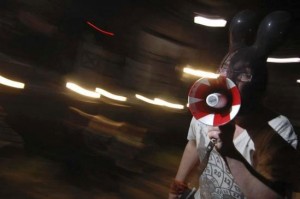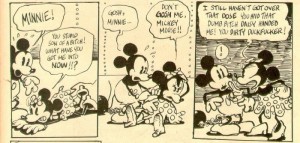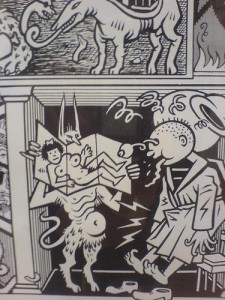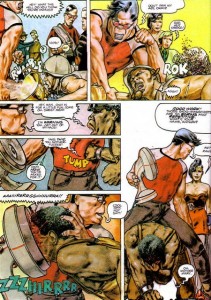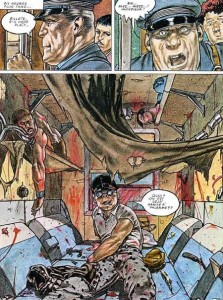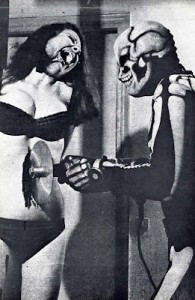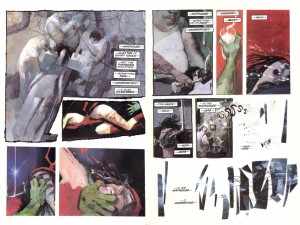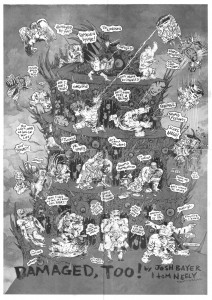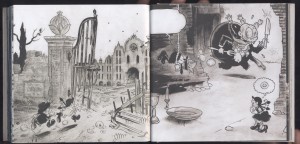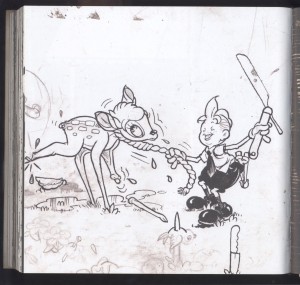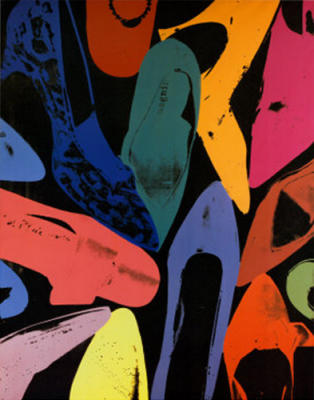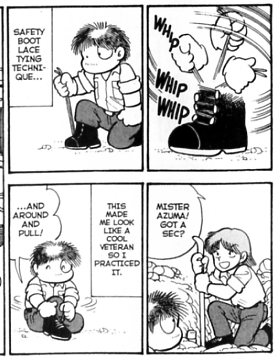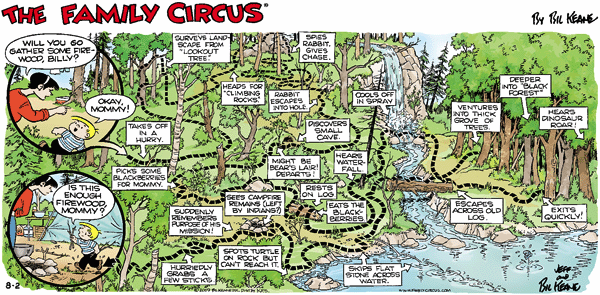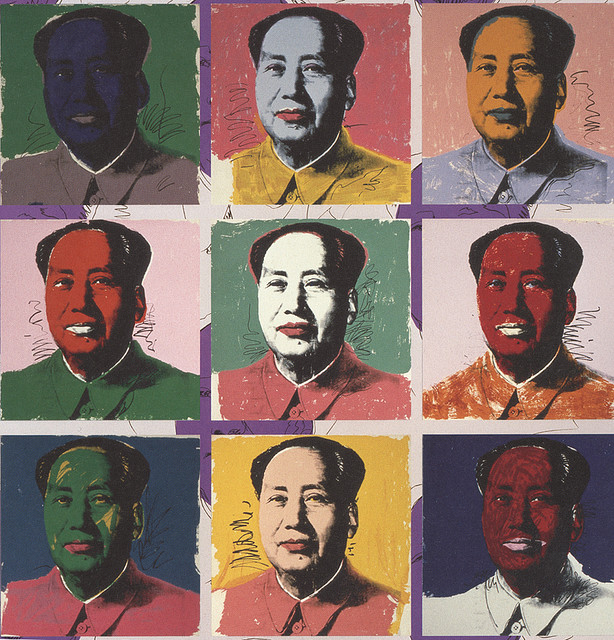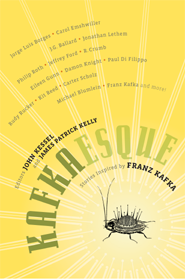From the Modern to the Postmodern Sublime.
There is no exact historic event to say when the modern ended or when the postmodern began. Even though World War I & II were certainly sublime in their scope, neither was the singular marker of transition. The transition happened more gradually as the individual neurosis of the modern gave way to the communal psychosis of the postmodern. However, what seems to be a constant is that comic artists have been there to comment on the types of madness that define those moments of change.
Ben Katchor’s Julius Knipl embodies the man who does not know where time and history begin and end, as he moves with a detached but detailed interest in his urban and banal surroundings. Katchor’s strangely anachronistic images offer a quirky and disturbing response away from the angst ridden narratives of the high moderns. Knipl is a photographer. He is in the business of making images. He reproduces the real with his camera. He looks and collects information about things that are in transition. He watches the people who engage in the remnants of a mechanically driven culture. Knipl’s is a gentle malady that draws one into a world without affect; a symptom of the postmodern condition.
After the wars, we tried to respond to the events of the recent past through the insufficient lens of the modern. Great thinkers and artists struggled to make sense of the human condition. They were neurotic, introspective, singular and alienated from society; they were outsiders. (The immediate problem with their strategy going forward was that we couldn’t all be on the outside.)
Mark Newgarden lampoons those great modern thinkers, Beckett, Joyce and Proust with his irreverent inclusion of “Mel.” His take offers a final ironic backwards wave adios to the modern past. Newgarden rejects the sanctity of deep thought that had become the cultural currency of a neurotic society. He deflates us all by brushing away the posture of alienation with the devastating tagline, ” We all die alone.” Which is to say conversely that we are all the same. Newgarden’s cartoon is a perfect transition from one historic state to the next, from the alienation of the modern into the communal ennui of the early postmodern.
The Disney Sublime: In the Belly of the Mouse.
In fact, the transition away from the modern happened not in a progressive manner, but rather when the postmodern went inside the beast and there found a different kind of collective madness. The French theorists, Roland Barthes, Derrida, et al, who arguably were the most influential thinkers post-WWII with respect to the use and effects of the media, produced the postmodern enfant terrible, Jean Baudrillard. For him, after the failure of the revolutionary 1968 Paris riots, the world fell into the throes of late stage capitalism and into a self-delusional state in which reality slipped farther from reach. Baudrillard’s focus is on the blurred borders between the media and the real world. He cites Disney as our commonly experienced reality-irreality. Baudrillard moves his critique from the outside to the inside, he sees our new form of delusional psychosis as stemming from inside the world of Disney, from where we are no longer able to experience alienation as we once knew it.
Baudrillard in a passage entitled “Hyperreal and Imaginary” in his famous essay “Simulacra and Simulations,” first published in Semiotext(e) in 1981, writes about Disney and comics as part of the cover-up of reality. He writes, “Disney is a perfect model of all the entangled orders of simulation.” He sums the scale of the problem as he understands it with:
The objective profile of the United States, then, may be traced throughout Disneyland, even down to the morphology of individuals and the crowd. All its values are exalted here, in miniature and comic-strip form. Embalmed and pacified. (…) Disneyland is there to conceal the fact that it is the ‘real’ country, all of ‘real’ America, which is Disneyland (just as prisons are there to conceal the fact that it is the social in its entirety, in its banal omnipresence, which is carceral). Disneyland is presented as imaginary in order to make us believe that the rest is real, when in fact all of Los Angeles and the America surrounding it are no longer real, but of the order of the hyperreal and of simulation. It is no longer a question of a false representation of reality(ideology), but of concealing the fact that the real is no longer real, and thus of saving the reality principle.
In Baudrillard’s view we are being deluded. Our sanity is being deliberately assaulted. Baudrillard’s mistrust of all things Disney is palpable. His vision of a world where reality and irreality meld in a simulacrum of the real is exemplified by Disney’s fantasies. Previously, Mickey as Steamboat Willie was an amusing mouse who transported the goods that modern America desired. He stood in for those capitalist/modern values as the trickster everyman trying to get ahead. Disney honestly doubled down on the moneymaking, yet societally we still wanted to think that art and our values belonged to a commercially untarnished sphere. Mickey was the emblem of the modern. For Baudrillard, Disney became the backdrop of global conglomeration, whose tricks threatened us from behind the veil of the corporate. And in his article one can detect the signs of the impending schizophrenia that will follow on from delusion. Who among you does not harbor mixed feelings about Mickey? Or at least Pluto? We are all victims of this confusion of values.
While Baudrillard’s position is also more than a little paranoid, the fact remains that Disney images are everywhere. One is forced to ask what effect does it have on us when cartoons, literally escape the panel borders and come to 3 dimensional life? Disneyworld, Broadway shows, toys, mugs, teeshirts and advertising occupy as much space as does any other cultural form; more perhaps. Baudrillard’s is a postmodern sublime that is the container for the vast entity of Disney.
Almost as if to make the point, a very recent news article entitled : “The Flight from Mickey into the Madness of Pyongyang, North Korea” reported the following :
— Mickey Mouse and Winnie the Pooh took the stage in North Korea during a concert for new leader Kim Jong Un, in an unusual performance featuring Disney characters. Performers dressed as Minnie Mouse, Tigger and others danced and pranced as footage from “Snow White,” “Dumbo,” “Beauty and the Beast” and other Disney movies played on a massive backdrop, according to still photos shown on state TV… the performance was staged Friday by the Moranbong band, which was making its debut after being assembled by Kim himself, the state-run Korean Central News Agency said. Kim, who took power after his father, longtime leader Kim Jong Il, died in December, has a “grandiose plan to bring about a dramatic turn in the field of literature and arts this year,” KCNA said.[1]
Mickey Mouse in Korea, onstage for Kim.
The Disney corporation did not give Korea permission to use their creations and one can only begin to imagine how Kim saw this interaction playing out. Perhaps he too is living in the fantasy world that Baudrillard presents. Inevitably Disney will ask for payment. But it perhaps hints at the dictator’s desire to put Baudrillard’s theory to work and to conceal his own brutal government with the warm and fuzzy.
Elsewhere, in Moengo, Suriname, Netherlander artist Wouter Klein Velderman built a giant wooden Mickey, assisted by local artists who carved totems into the legs. This inclusion Klein Welderman felt, somehow made it possible for the people to feel some autonomy in the coming industrialization of their country. The piece is entitled “Monument for Transition.” It is his warning of what they are to expect. What ever his motivation, Disney is now a real wooden artifact, standing securely on the cultural icons of Moengo’s heritage.
Moengo, which has only recently put a violent civil war behind it, needed to be warned by the presence of the Mouse. A little farther north at the Lone Star Performance Explosion, Houston’s International Performance Art Biennial, the Non Grata performance group donned latex Mickey hoods/masks and trashed a car with sledge hammers and explosives. I have to admit that this piece probably has more impact live and that I’m kind of delighted by the vigor of their gesture. But I want to draw attention to how Baudrillard’s once extraordinary theory has achieved in certain circles a common acceptance.
The early postmodern up-side of this if you will, is that bursts of anti-Mickey propaganda emerge from the margins to remind us of just where we really are. These various incursions into Disney property found early expression in the totally subversive and inspired Air Pirates work.
In these strips, Minnie and Mickey are caught in unguarded moments. We see their life behind the spotlights. Of course, this only adds another layer of confusion, because these comics fracture an imaginary world, but for a moment the reader is able to say “I knew that they were really like that all along.”
But if Baudrillard sees us living in a delusional state, Fredric Jameson in his 1991 essay “Postmodernism or, The Cultural Logic of Late Capitalism” sees us experiencing a kind of schizophrenia. He elucidates his view of our affectless culture, which he suggests is built on the edifice of the late stage of capitalism. He writes of the parameters of his project:
I have felt, however, that it was only in the light of some conception of a dominant cultural logic or hegemonic norm that genuine difference could be measured and assessed…The postmodern is, however, the force field in which very different kinds of cultural impulses – what Raymond Williams has usefully termed “residual” and “emergent” forms of cultural production – must make their way. If we do not achieve some general sense of a cultural dominant, then we fall back into a view of present history as sheer heterogeneity, random difference, a coexistence of a host of distinct forces whose effectivity is undecidable…The exposition will take up in turn the following constitutive features of the postmodern: a new depthlessness, which finds its prolongation both in contemporary “theory” and in a whole new culture of the image or the simulacrum; a consequent weakening of historicity, both in our relationship to public History and in the new forms of our private temporality, whose “schizophrenic” structure (following Lacan) will determine new types of syntax or syntagmatic relationships in the more temporal arts; a whole new type of emotional ground tone – what I will call “intensities” – which can best be grasped by a return to older theories of the sublime; the deep constitutive relationships of all this to a whole new technology, which is itself a figure for a whole new economic world system.
Jameson later discusses how a postmodern sublime encompasses the relentlessly promulgating cultural media; film, TV, internet and electronic gadgets of all kinds, which destabilize our sense of self and fracture our psyche. In the arts, he sees only reproductions, which no longer parody their models, but rather that are affectless pastiches which offer nothing but a reflection of the citizen, who is now beyond-disaffected, beyond the neurosis of the existentialist, beyond all expressionist’s anxiety and finally in a dazed state of psychosis.
Jameson points out that the sublime of postmodern is not the dark and brooding place of the high romantics; it is not the depressed world of brooding heroes. Somewhere along the line, all of that angst and personal introspection has been replaced by another world of bright shiny surfaces, replicas and fragmented visions in a world now experiencing another kind of psychic onslaught. Jameson talks about the postmodern sublime as a type of container for all this madness, which he describes as a type of schizophrenia. Some comic artists were ahead of this curve. Newgarden seems to have nailed it, along with his cohorts at Raw. In part under the intellectual guidance of Francoise Mouly and Art Spiegelman, the french philosophical influence is evident in their editing.
Early Postmodern Shinings.
In a particularly postmodern way, a new insanity entered the pages of comics and schizophrenia became the new model.I still remember my first encounters with Stefano Tamburini and Tanino Liberatore’s (Rank Xerox) Ranxerox in 1978 and how I was still shocked by the unaffected violence.
Ranxerox was a mechanical creature made from Xerox photocopier parts and there was a randomness in his acts of violence that seemed to have no self-consciousness, no motivation and suggested a different sort of sociopathic absence of rationality. He was in fact, the embodiment of the age of mechanical reproduction. His violent acts were simply there, monstrously accumulating on the pages and refusing to be contained in any prior system of logic. His surfaces were shiny and he appeared smooth as if airbrushed into reality; he was alternately sexual and violent.
Ranxerox by Stefano Tamburini and Tanino Liberatore
The pantone pen technique used brought the character to life in a way that separated Rank from the art of the fumetti style Italian horror comics, such as Satanik and its predecessor Fantomas by Alain and Souvestre. The reader and the characters in these comics were aware that certain boundaries were being crossed, as they engaged and became archetypal villains, whereas in Liberatore’s world the characters remain largely oblivious.
Another train rider of the early postmodern is Panter’s Jimbo, whose blank ferocity reflects perfectly the explosion of media and the madness of everyday life. Jimbo lives surrounded by shakily drawn monsters and aliens. His reality environment sits between the real and the unreal.
Several years later in 1986 American bred, Elektra: Assassin, came to vivid and stylishly bloody life in the hands of Bill Sienkiewicz. With Frank Miller’s script, her madness was eroticized and melded with uncontained and unconscious violence. Elektra, an understood schizophrenic, is seen in her hospital room, incapable of managing her life. Unclear as to what or who she is (and of course this is Miller nailing the post modern condition) while she pursues her day job as assassin and her nights are spent in the confines of the institution. Her mental state is depicted as something more akin to her natural condition. Sienkiewicz’ art is a tour de force of photocopy, parody/pastiche and repetitions.
Sienkiewicz in what promised to be a new life for mainstream comics, used different mediums and techniques that both reflected technological advances and presented a comic that drew inspiration from myriad sources. The art is constantly changing its style and represents a reaction to the seeming explosion of new media as computers, satellites and early cell phones accelerated communication.
However, as Jameson also notes in his essay, boundaries are no longer held in check by any social mores, because we have been saturated and inured to images of violence, sex and those things that were once held distasteful since we have been institutionalized and sanctioned as part our lives. Jameson writes about this cultural numbing:
As for the postmodern revolt against all that, however, it must equally be stressed that its own offensive features – from obscurity and sexually explicit material to psychological squalor and overt expressions of social and political defiance, which transcend anything that might have been imagined at the most extreme moments of high modernism – no longer scandalise anyone and are not only received with the greatest complacency but have themselves become institutionalised and are at one with the official or public culture of Western society.
The Late Postmodern or the Post post modern even.
Josh Bayer and Tom Neely depict beings who no longer feel while other cartoon characters look out from the “secret prison” of Black Flag’s song. Nancy, Wimpy and Little Orphan Annie, Krazy Kat, Jughead, Mutt, Jeff, Goofy and Mickey peer out from behind bars while troubled figures lament how they have been ruined by comics and how they no longer can feel anything. The past exists in the sampled figures of cartoon culture. Dante is trampled underfoot and we are given a post-postmodern hell. These images of madness question where we exist after the punishment of the cartoon, what circle of media hell is home for us once we are conscious. This is the schizophrenia of the postmodern that Jameson describes.
Al Columbia’s Pim and Francie perhaps sums it all up. They run not walk to the sanatorium. Columbia’s characters are no longer in revolt, they are beyond that cognitive choice. Rather they live in a world that does not differentiate morality and feelings. Columbia draws snatches from various artists styles. They hover ghostlike, pulled back from our collective memory as they sit on pages that are torn, fragmented and abused in a confrontation of what it means to be a new product. Jameson suggest that nothing is left to shock us, but I’d suggest that Al Columbia does just that. In this final image the boy takes a straight razor to Bambi. He eschews the choice of Mickey and assaults us in the soft spot. Bambi, the sacred lamb, the sacred cow, the holy sanctified symbol of innocence, is offered to the madness of the postpostmodern. Bambi’s limbs lie dismembered in the grass and we are oh so close by, to see them.
[1] http://www.deseretnews.com/article/765588670/Mickey-Mouse-takes-N-Korean-stage-in-show.html
http://www.telegraph.co.uk/news/worldnews/asia/northkorea/9385901/North-Korea-Kim-Jong-un-enjoys-unauthorised-Disney-show.html


